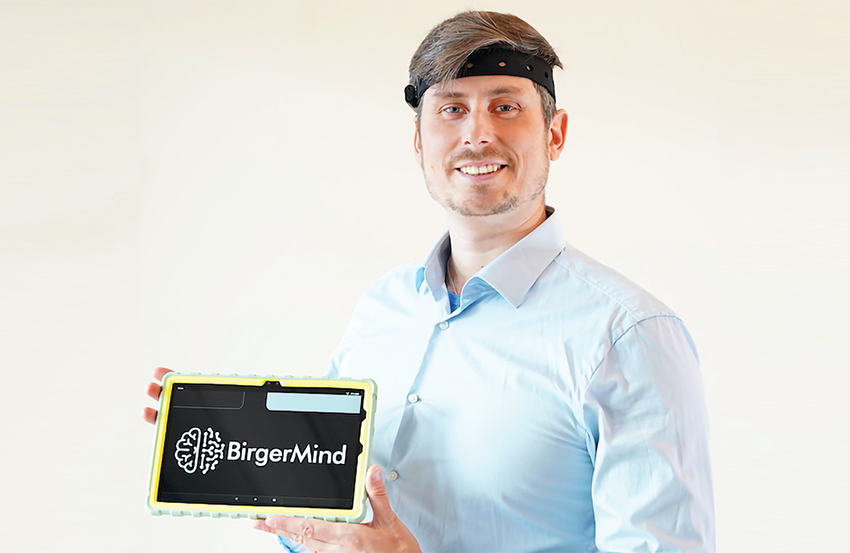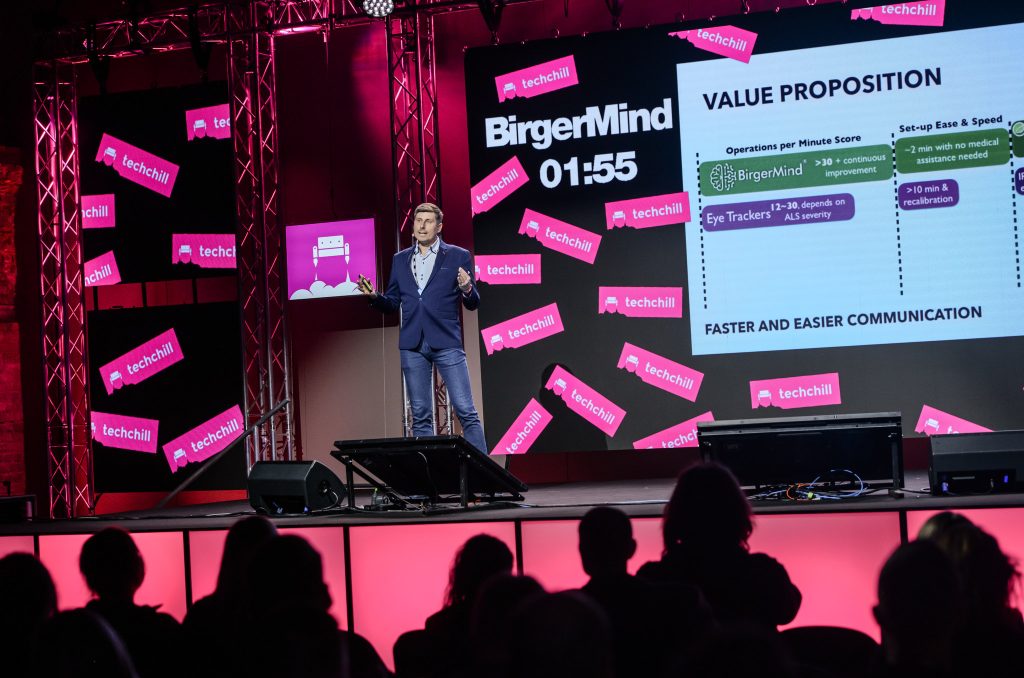According to the 2019 Global Burden of Disease, Injuries and Risk Factors study, there are approximately 269,000 Motor Neuron Disease (MND) group patients worldwide, with 63.7 thousand new diagnoses each year. In 2019, over 39,000 people died from MND. With an aging population and advances in healthcare that prolong the lives of MND patients, their number is increasing. Consequently, there is a growing need to help paralyzed MND patients with their ability to communicate.
Amyotrophic Lateral Sclerosis (ALS), also known as Lou Gehrig’s disease, is one of the most severe diseases in the MND group. It is fatal and practically the only one in the group that completely robs people of their ability to communicate. “Currently, there are about 40-50 ALS patients in Latvia,” says neurologist Viktorija Kenina, the chief physician of the Rare Neurological Disease Center. “Because ALS severely affects the quality of life and patients cannot manage without assistance, there is little chance that there are many undiagnosed people in the country. The road to diagnosis may be longer for some and shorter for others, but once the symptoms intensify, everyone will understand what kind of disease they are dealing with.”
In Latvia, ALS patients are treated in university clinics, such as the Rare Neurological Disease Center at Pauls Stradins Clinical University Hospital, where V. Kenina’s team of doctors strives to provide them with multidisciplinary care. Unfortunately, the only available ALS therapy today only slightly prolongs life expectancy (by an average of 3-6 months). Although specialist care is more effective, there is no expectation of a miracle happening – so patients often receive treatment where it is more convenient for them and their families (especially those who live outside of Riga).

Stephen Hawking, 2007. Kim Shiflett/NASA
The Stephen Hawking Phenomenon
However, there are cases where patients live much longer – the most famous example is scientist Stephen Hawking, who was diagnosed with ALS at age 21 and lived until age 76. Not all ALS diagnoses are identical, and Hawking is one of the very rare patients who retained breathing function for a long time. Of course, it also depends on the quality of healthcare that is available to the patient.
ALS progresses rapidly and gradually paralyzes the entire body’s musculature. V. Kenina emphasizes that the onset of the disease can vary, but usually, the loss of movement function in the hands and feet comes first, followed by speech loss, swallowing problems (which eventually require gastrostomy – feeding directly into the stomach), and eventually even loss of breathing – meaning that the patient’s life must be maintained with the help of artificial lung ventilation equipment. The person remains trapped in their body because ALS does not affect their cognitive abilities.
Among the longest-functioning muscles are the patient’s forehead and eyes – that is why until now, communication technologies have worked by scanning their respective movement. However, sooner or later, the patient loses all muscle function, and that is the reason for research and technologies that would provide opportunities to allow them to communicate only with the power of thought. “This would be particularly significant for patients whose symptoms have very early on affected their ability to communicate, as their bodies can still live,” explains V. Kenina.
Controlling computers with human brainwaves
For about 16 years, Juris Klonovs has been developing a project that sounds almost like science fiction – controlling computers and mobile devices with human brainwaves. It started as a passion during his studies in Latvia, 2007, when he created the first rudimentary prototype, and continued in Taiwan during further education in artificial intelligence and human brain function. “Countless evenings have been spent on this project since then,” says J. Klonovs.
Next followed a seven-year period in Denmark, during which J. Klonovs completed two master’s theses, finished his doctoral studies, and continued to work with medical equipment that analyzes brainwaves in Danish hospitals, for example, for diagnostic purposes. During this time, he established close contacts with world-class neurology specialists and could work with a large volume of medical data, which was a vital experience for developing the technology further.
Friendship with a patient influences technology development
While in Denmark in 2011, J. Klonovs met Birger, an already completely paralyzed ALS patient. They quickly became friends, and Birger became the primary tester of the technology. “At first, I was surprised that Birger knew nothing about the possibility of controlling a computer with the power of thought,” says J. Klonovs. “After several years of working on it, I had convinced myself that it was a well-known possibility.” He continued to visit Birger regularly, constantly developing prototypes – which was especially important because as the disease progressed, it became difficult for Birger even to move his eyes, making eye scanners very tiring to use.
The operation of the equipment is simple – by reading brain activity as bio-potential differences between sensors, information is sent to a computer where the data is processed in real-time and converted into a specific signal. The precision of the technology is influenced by the number of sensors – for example, if there are 16 sensors, a powerful computer is required to handle the data flow easily. That is one of the reasons why this technology has only become relevant in recent years.

BirgerMind setup – cap and screen with specialized software
Machine Learning
The next important element are special machine learning algorithms – J. Klonovs says that software is almost more important than the equipment itself. The computer needs to be able to correctly recognize, analyze, and classify acquired data based on its characteristics. Therefore, it has been essential to accumulate medical data of ALS patients, recorded according to a particular protocol and annotated by a specialist. This data is used to train machine learning algorithms to translate brain activity into instructions for the computer as accurately as possible.
The basic commands are – right, left, up, down, and enter (confirm). Each patient has a different imagination, so the device usually needs to be calibrated – but for the most part, human brain waves are stable, so repeated calibration is no longer necessary (as it is for other types of ALS patient communication devices). The algorithm can follow small changes and adjust to them.
J. Klonovs emphasizes that a fundamental principle of this technology is to adapt it to the needs of each patient. If the patient can still move some muscles, it is possible to add additional sensors that improve control capabilities. However, this is more complicated than using a simple sensor “cap” on the head that can be used without special training for assistants. Similarly, it is possible to activate a process that tries to look at the brain waves and determine where on the screen the patient is looking at. In such a scenario, only one command is needed – enter. Although the accuracy still needs to be improved, this option can work more effectively than current eye scanners, which require precise scanner and head positions, and can strain the eyes.
Regarding software, a lot of work is needed to adapt various applications – although theoretically, a person could use any computer, applications are usually developed for healthy people who use standard keyboards, mice, or touch screens. And as with developing new software, it is necessary to translate it into different languages – which is especially important for the function that reads written text aloud to work correctly.
Formation of BirgerMind
For a long time, the project depended on parts that J. Klonovs and his team could not manufacture – for example, motherboards and sensors. In this field, it was nothing unusual – other similar projects primarily focused on some narrow technology and rarely had the necessary software developed even close to the possibility of using this technology practically. Therefore, J. Klonovs is pleased that it is now possible to produce everything in Latvia (although not on a mass scale), and although his team currently does not have direct access to specialized premises, they can be rented in Latvian laboratories.
Of course, this technology can also be used more broadly – many people and business experts have recommended J. Klonovs not to look so narrowly at paralyzed patients but to expand into gaming and other entertainment areas. However, he believes it is necessary to maintain the primary goal, as there are enough patients with ALS (and those who are paralyzed for other reasons) for a startup to take off.
In 2021, J. Klonovs founded the company BirgerMind, naming it after his friend with ALS. Since then, the project has been more focused on various innovation competitions and support programs (because until now, J. Klonovs and his team financed it themselves by outsourcing their knowledge and skills) and starting the patenting process. Currently, about 30 patients use BirgerMind software, and 10 use prototypes of brain wave sensor equipment developed over the years – each customized for their own needs and desires (certain operating systems, etc.), as the equipment is not yet mass-produced. The BirgerMind system is currently the only one in the world that can be operated even with closed eyes and the help of sound. J. Klonovs team is working hard to ensure the production process and expand the solution’s functionality. It is planned to provide equipment to 1000 patients within five years, thus significantly improving their quality of life. It is also worth mentioning that the company has recently created the ALS.CARE platform, where patients are invited to report their needs and desires to find an individual solution.
DeepTech hardships
While working with MedTech and DeepTech companies in Denmark that had difficulties with medical equipment certification, J. Klonovs saw how this process requires hundreds of thousands of euros in investment. And there are many such certificates, especially for a company expanding globally – because each region has its own regulations. To avoid jumping into this hole for now, BirgerMind focuses on equipment and software as an additional mechanism for data input. Nothing is diagnosed, and there is no involvement in any medical tasks. This means that CE marking and compliance with other EU and Global regulatory requirements, such as RoHS/REACH, BQB, IEC 61000, ISO 27001, UL1642, WEEE etc. (including those that are related to data processing – so that with patient permission, their non-personalized brainwave data can be used to improve BirgerMind’s algorithms) is sufficient. In other words, BirgerMind is not considered medical equipment. At least for now – J. Klonovs added that if there are resources to obtain all the necessary certificates, then it will definitely be done.
This article was created in partnership with Medicus Bonus – a Latvian magazine for healthcare professionals – in a new series about healthcare innovation happening in Latvia. If you are a doctor, the subscription is free – just write to redakcija@medicusbonus.lv !




